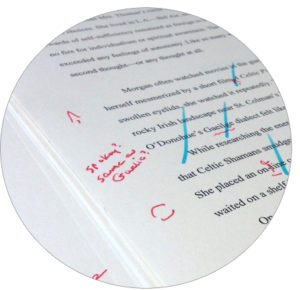Professional Editing

Skilled editors can help authors transform an ordinary manuscript idea into an extraordinary book. it can help your book rise above other self-published books, not to mention make it marketable. Nothing shouts non-professional self-publisher (aka DIY) louder than a poorly edited manuscript.
The various kinds of editing can be very confusing however what is most important is that your manuscript goes through all the steps. You might not need a developmental editor but even if you’re an editor yourself, a professional should read the manuscript and watch for errors and inconsistencies. (I once heard of a manuscript getting all the way to the design stage before someone noticed that the protagonist was pregnant for 18 months. The author had a lot of work to do to fix the HUGE oversight.)
Developmental editing will deal with “big picture” issues
Developmental editors (also called content or substantive editors) provide detailed feedback on the big picture, once you have finished the first draft. They will help you get the manuscript into its final form, which may involve reordering or rewriting segments to improve readability, clarity, or accuracy. If you’re a fiction writer, a substantive editor can alert you to inconsistent character behavior or speech, help you adjust your language to your desired audience, and make sure your story has believable dialogue and a plausible plotline. Expect to receive a marked-up version of your original manuscript with suggestions for each issue.
Copy editing is the next step
Copy editors (also called mechanical or line editors) watch for anything that makes your manuscript less readable, like word repetition or character inconsistencies. This is where the “readers advocate” comes into play. The copy editor’s goal is to bridge the gaps between your intent and how the reader will understand the text.
The copy editor will watch for and correct:
- Spelling
- Grammar
- Capitalization
- Word usage and repetition
- Use of dialogue tags
- Consistent use of numbers or numerals
- Shifts in point of view or tense
- inconsistencies in character descriptions, locations, etc.
- foot note references (see fact checking below)
- historical consistency – This is especially important for historical fiction. [I recently read a book set in the 990s. One of the characters noticed a bug in the army’s attack plan. In the 990s, a bug was an insect not an error in a plan! Another one I noticed; until recently no one used the word pregnant. Women were expecting or with child.) Copy editors watch for these oversights.
Don’t go ballistic if the copy editor misses a typo or misspelled word, copy editors are human–mostly. There is one more step–proof reading.
Proofreading
Proofreading is the last stage of the editing process. Proofreaders read the manuscript after the designer’s layout is finished and carefully inspect the manuscript for the spelling and grammatical errors that may have made it to the final version.
- They watch for:
- Inconsistencies in spelling and style (hyphenated words, etc.)
- Inconsistencies in layout and typography
- Confusing or awkward page breaks
- Incorrect captioning
- Incorrect page reference numbers (see illustration on page xxx)
- When the proofreader returns your marked up manuscript, ARG! you need to make the changes and re-read the entire book cover to cover AGAIN.
Fact-checking
Fact checking is in the news a lot these days and there are numerous cyber tools to help. No matter how thoroughly you research your book, it can still end up with informational inconsistencies. Developmental and copy editors may notice and check the internet or at least raise red flags.
Depending on your genre, you might consider getting a designated fact-checker to read through your manuscript and confirm via external sources.




